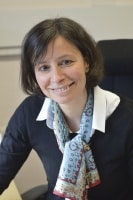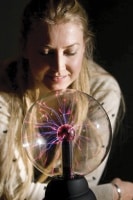Prof Paola Lettieri – vice-dean (strategic projects) in the Faculty of Engineering Sciences and professor of chemical engineering at UCL

As well as being a professor of chemical engineering at UCL, Paola Lettieri is also the vice-dean of strategic projects in the engineering faculty. Right now that role is keeping her very busy, as the university develops its UCL East campus in the Queen Elizabeth Olympic Park.
She is also the first female engineer to be awarded a RAEng Fellowship, and is a fellow of the Institution of Chemical Engineers (IChemE). Energy systems are a particular area of expertise, and she is currently involved in research on energy from waste gasification, as well as the life cycle of nuclear waste management.
“During my fellowship, which was entitled ‘Fluidisation for Sustainable Development’, I had a vision of working on fluidised processes that would have applications related to the incineration or gasification of waste,” she told The Engineer.
After honing her skills with BP for a number of years across a range of projects, Lettieri got a chance to build on her initial fellowship and explore the commercial possibilities of waste gasification. Working in collaboration with energy company Advanced Plasma Power (APP), she helped develop a process that combines gasification with plasma conversion, using waste to produce a synthetic gas (syngas) that is highly versatile.
“The Gasplasma cycle, which is what the process is called by APP, starts off basically with waste collection. This can be domestic waste, or industrial commercial waste. It is basically sorted so that the metal, the plastic and the glass is separated. The rest of the waste goes to what is called the ‘fuel preparation’, where it is shredded and dried, until it becomes a fluffy RDF [Refuse-Derived Fuel] that goes into the fluid-bed gasifier.”
The gasifier is a metal vessel filled with extremely hot sand, suspended using steam and oxygen. RDF is pumped into this vessel, setting off a series of reactions that produces a syngas made up of hydrogen, carbon monoxide, carbon dioxide, steam and tar. The gas then passes through
a plasma converter, which operates in excess of 8,000°C. Here, the tars are broken down and separated from the syngas, which is purified and cooled before entering the power system. The gas can be used for heating, electricity generation, Bio-SNG production, and even in fuel cells.
“The beauty of the Gasplasma cycle is that basically you crack down the tars,” said Lettieri. “The presence of the tars in the syngas are the very reason why today, gasification of waste is not such a well-established technology.
It’s also got the flexibility at the end of giving you energy from waste, where energy can be electricity, can be heat, can be biofuel, can be a substitute for natural gas.”
“There are 60 million tonnes of waste produced annually in the UK, and the equivalent energy content of that is 510 million gigajoules (about 85 million barrels of oil). So waste can really contribute by a large amount to the energy mix.”
While waste has the potential to play a major role in the UK’s energy future, nuclear is virtually guaranteed to do so. Projected to make up 40-50 per cent of the energy mix by 2050, the recent announcements on Hinkley are a major step in this direction. Prof Lettieri’s second and current fellowship with the RAEng involves weighing the pros and cons of both closed and open nuclear cycles, and assessing the entire nuclear waste management life cycle.
An aspect of this includes investigating the viability of a geological repository for the long-term storage of high-level waste in the UK. The current policy is for a voluntary approach to siting the facility, but there are some who view this as unrealistic.
“I think it’s about educating the public, because I don’t think there is a risk in terms of the solid emissions from the waste that will be stored in the geological repository,” said Lettieri. “There are already studies that have actually quantified and predicted the emissions from solid waste, and it is shown that these emissions will be very, very low.”
“Nuclear may sound like a scary business for people who are not engineers, and do not necessarily have the background to understand what it involves. I think going through that process of looking for
a community that voluntarily is happy to host a repository, is part of educating the community that this can be done.”
Jackie Anderson – engineering manager working for Carrier, an air-management systems organisation at United Technologies Building & Industrial Systems

After working for her father’s bridge construction company from the age of 14, engineering was the obvious career choice for Jackie Anderson. She obtained her master’s degree from Rochester Institute of Technology and her PhD from Syracuse University.
In both instances, her thesis was based on fluid dynamics, and this expertise would serve her well on a unique project she worked on for Carrier, part of United Technologies.
“The Sistine Chapel project was just beginning when I was hired at Carrier,” Anderson says. “My background for my PhD was indoor air quality where I used CFD [Computational Fluid Dynamics] to model different nozzles and diffusers to deliver air into interior spaces.
This project was a natural extension of that work, but on a more challenging level.”
Anderson was in charge of modelling the indoor air quality of the Sistine Chapel and ensuring the velocity of the air being delivered to the chapel was minimised to protect the frescoes. She also designed the air diffuser that was installed below the chapel’s windows, reducing air velocities and allowing more visitors through the chapel.
“There were several factors that were critical when implementing the new HVAC solution: low velocity to limit scrubbing effects on the frescoes; reduced levels of CO2 to limit the formation of calcium bicarbonate, which creates a whitish film on the surface of the frescoes; and controlled air temperature and relative humidity to limit fluctuations across the fresco surfaces.”
“In addition, because every part of the Sistine Chapel is covered with priceless artwork, we didn’t have the luxury of making structural changes to accommodate our design. These restrictions created the opportunity to develop a custom diffuser, which allowed us to supply more air to reduce CO2 concentration levels, remove particulates, and control the temperature and humidity, without increasing velocities within the space.”
Melanie Windridge – plasma physicist with a PhD in fusion energy from Imperial College London. Consultant for start-up business Tokamak Energy

Although physics was the least popular subject in the girls grammar school that Melanie Windridge attended, it was always her favourite.
She would go on to get a PhD in plasma physics from Imperial College London, as well as become a lecturer for the Institute of Physics Schools.
Her first book, Star Chambers, is a collection of her experiences teaching school children about nuclear fusion. Windridge also works as a consultant for Oxford company Tokamak Energy.
The Engineer asked her to set out the pros and cons of two competing fusion technologies, namely tokamak and inertial confinement.
“The thing to remember is that there are several cross-overs between the two, and areas for collaborative research,” she said. “For fusion reactions to happen, the fuel plasma must be kept hot enough for long enough for fusion to occur. The tokamak and the lasers are different ways of heating and confining the fusion fuel.”
“Outside of that – e.g. extracting energy to make electricity, breeding tritium fuel, protecting sensitive components – there are commonalities. Both tokamak and laser communities are getting close to achieving energy break-even, but arguably tokamaks have a slightly more developed path to commercialisation. The lasers themselves require quite a big jump in technological capability if they are to fire frequently enough for power generation.”




Project to investigate hybrid approach to titanium manufacturing
What is this a hybrid of? Superplastic forming tends to be performed slowly as otherwise the behaviour is the hot creep that typifies hot...